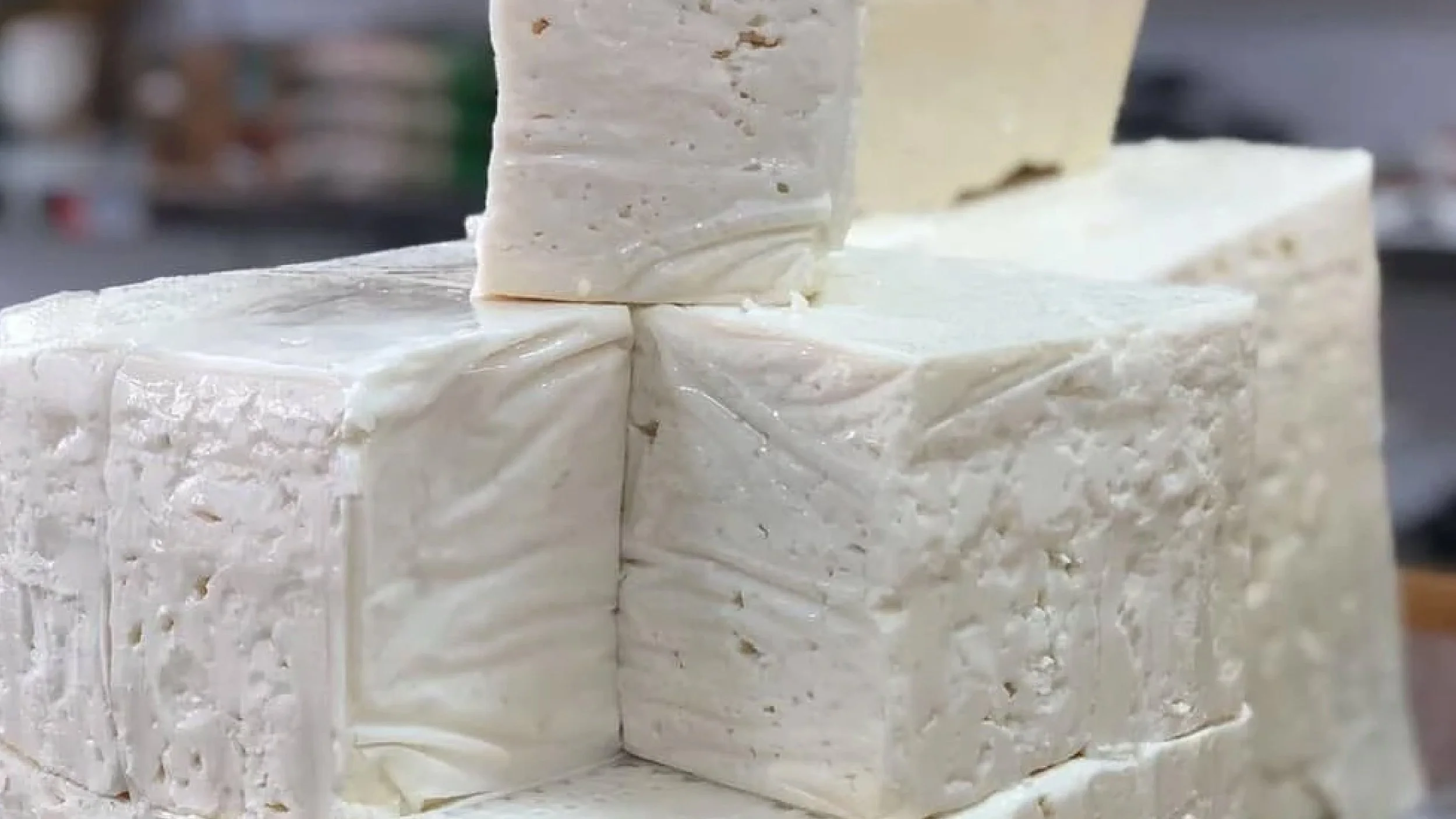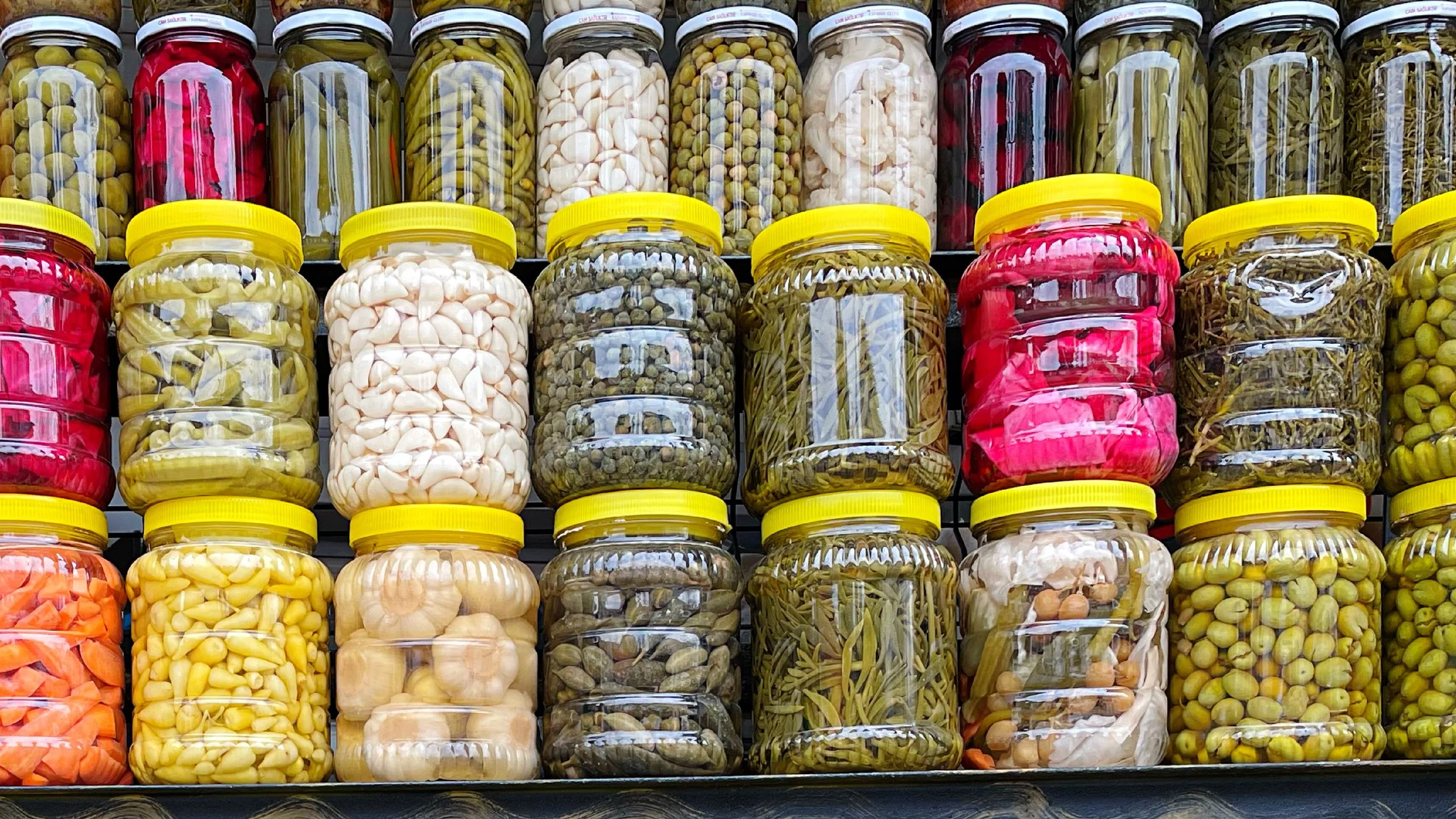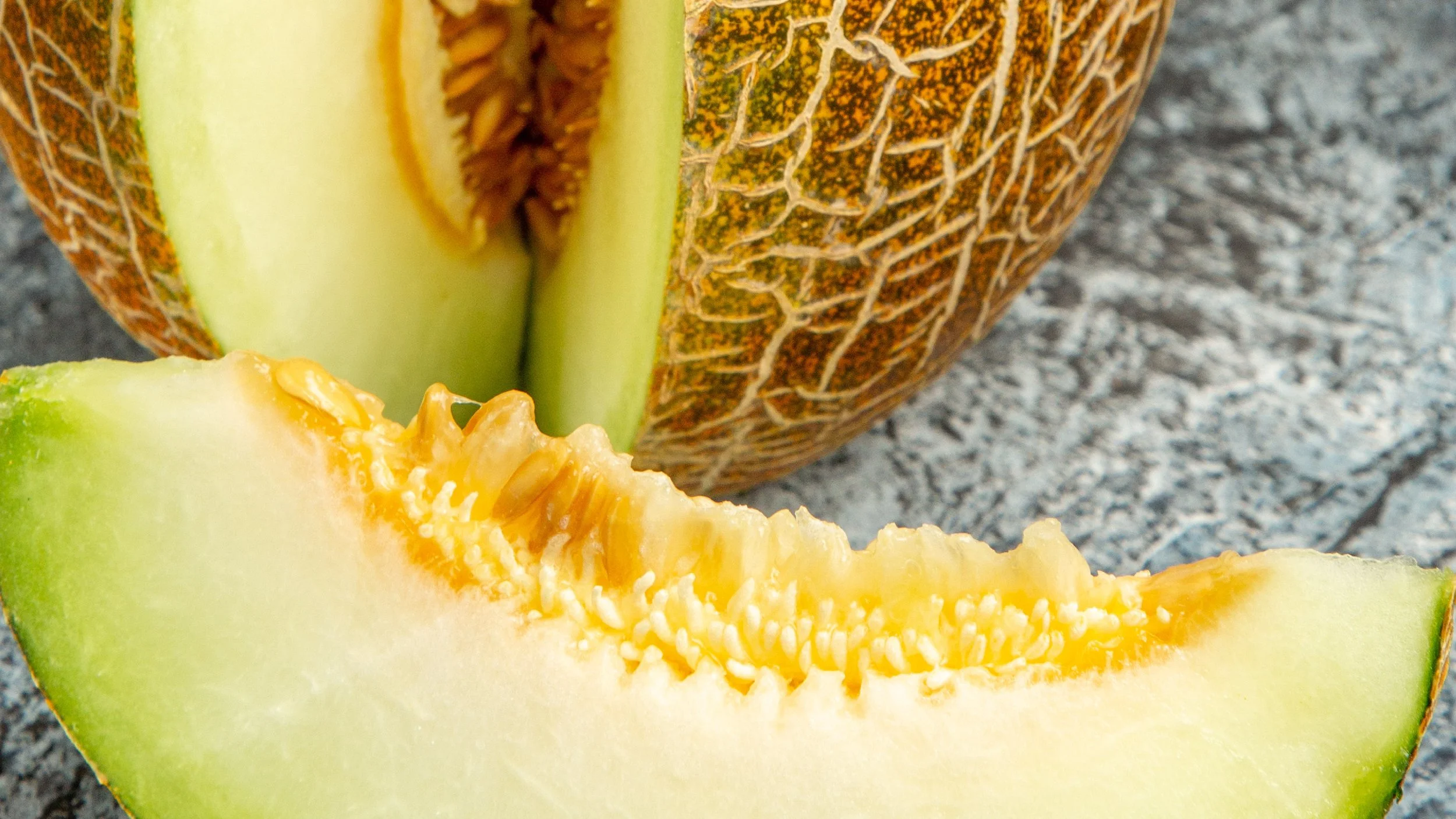Sidekicks (yancılar), or the odd ones out
White Cheese (Beyaz Peynir)
Its presence seldom realized, but absence immediately noticed, white cheese is a sine qua non for a meyhane.
Yet, not every white cheese can meet habitués’ standards – it has to be full-fat, neither too hard nor too soft, and satiating with each bite. And, the less satisfactory a meyhane’s white cheese offering is, the less the likelihood of clients revisiting it.
The sight, perhaps, is not as appealing as white cheese’s status at the rakı table would imply: a slice, often a triangle, cut using a string so as to avoid crumbling, sits on an indistinguishably white- or cream-colored plate. Even the strategic placement of scarlet red tomatoes and virid cucumbers on the plate can only do so much to embellish it. But what matters more than the looks of white cheese is what it symbolizes: the start of an afternoon, evening, or night spent conversing and sharing with loved ones.
Visiting Constantinople in the mid-16th century, German traveler Hans Bernschwam wrote: “Turks love their white cheese.” Of course, this was no surprise in a city famous for its dairy farms (mandıra) since the days of Byzantine rule. The demand for high-quality dairy products – particularly cheese, yogurt, and clotted cream – surged after the Ottoman conquest, and as a result, dairy farms mushroomed in and around the capital. Indeed, by the mid-17th century, according to the Ottoman travelogue Evliya Çelebi, 2,000 farms spread over the city and its surroundings could barely meet Istanbulites’ demand.
Today, as a consequence of unplanned urbanization and mass migration, only 218 dairy farms remain in Istanbul, and they cannot meet the city’s demands in either quantity or quality. Since the number of dairy farms and the quality of products started to diminish during the 1950s, Istanbulites have turned to nearby cities to satisfy their hunger for delicious white cheese. For a long time, Edirne, located in the Thrace, was the chief provider of top-shelf white cheese in Istanbul but, more recently, Ezine cheese (named after the small town in Çanakkale (Gallipoli) it is produced), has become the undisputed king of rakı tables.
For Byzantines, consuming cow milk was a sign of vulgarity and lack of refined taste. Istanbulites have inherited this preference for goat and sheep milk, and it is no surprise that Ezine is the top choice white cheese for meyhanes and urbanites alike. The mark of origin on its packaging guarantees consistency of quality and ingredients – 35-45% sheep milk, 40% goat milk, and a maximum of 25% cow milk – which appeals to Istanbullites’ palate.
In Ottoman Istanbul, most urbanites bought their white cheese from licensed cheesemongers. As the foreign population in the capital increased during the early 19th century, charcuteries selling all types of local and imported cheese and cold cuts among other things, appeared in Pera and Tarabia (where summer residences of most embassies were located).
The early 20th century witnessed a surge in the number of small, independently owned corner stores called the bakkal, and it was these shopkeepers that provided the city with white cheese for decades. Cheese would arrive in 20-litre tin canisters bearing the name of the dairy farm that produced it. The neighborhood residents, often closely acquainted with the shopkeeper, would either buy their preferred “brand” or seek advice from the bakkal, as he knew what their regulars liked better than anyone else.
Today, with bakkals all but disappeared, it is charcuteries, specialized cheese shops, and supermarkets that cater to Istanbulites’ white cheese demands.
And, as the prices of all dairy products have skyrocketed in recent years, urbanites have mostly turned to cheaper, albeit considerably less pleasurable white cheese options offered by supermarkets.
The association of rakı with a particular kind of white cheese has been so deeply embedded in the city's collective consciousness that in charcuteries and cheese shops, you often hear someone asking for a block of rakı or meyhane cheese. And without any further explanation necessary, the cheesemonger knows exactly what they want.
Pickles (Turşu)
The origins of pickling in the city go back to Byzantine times. The citizens would preserve vegetables that did not grow in winter in brine. Called halmaia by locals, the brine used for pickling was only available at phouskaria, that is the Byzantine meyhane.
Although it started as a functional practice allowing people to enjoy fruits and vegetables out of season, pickling soon took a palatal turn. The crunchy texture and the salty, garlicky taste were so appealing that preservation took a backseat as people started to enjoy pickled versions of fruits and vegetables even when they were in season.
Although the majority of Ottoman Istanbulites pickled in their own homes – and, we should add meyhane owners in the cellars of their establishments – there were 87 registered pickle shops in the city at the beginning of the 19th century. And, picklers offered a sight to behold when they loaded their handcarts with jars, roaming the streets and exhibiting their artwork to urbanites watching the procession from their windows, coffeehouses, or shops.
Had it not been for the truck gardens (bostans) spread out across the city and its surroundings, pickling would not have become such a passion for Istanbulites. These gardens that had been provisioning Constantinople with fresh vegetables, greens, and fruits from the 5th century onwards became even more fertile after the Ottoman conquest. The Ottoman rulers rightly considered the truck gardens as the means to secure the livelihood of the ever-increasing population.
Yet, it wasn’t just the amount but also the deliciousness of the products grown in these gardens – as attested to by every European traveler visiting the city before the second half of the 20th century – that came into play here. Because, when it comes to pickling the math is simple: your pickles will only taste as good as your ingredients.
Istanbulites took pickling so seriously that many knew which truck garden’s produce was the best to pickle: cucumbers (hıyar) from Langa (located in the old quarter), smaller cucumbers from Çengelköy (on the Asian shore of the Bosporus), aubergines (patlıcan) from Beykoz (lies at the northern end of the Bosporus on the Anatolian side), and okra (bamya) from Vidos (Güngören, west of the city walls).
Although many of the truck gardens in and around the city disappeared during the second half of the 20th century, pickling culture didn’t. Today, when the season arrives (early fall) Istanbulites swarm the turşuluk (for pickling) stands in neighborhood markets, picking their vegetables one by one, bickering with the vendor over price, and wistfully reminiscing about the olden days when produce tasted good.
Three ingredients, other than that which is being pickled, of course, are of vital importance: dill, rock salt, and garlic. Dill has to be of emerald green color and garden variety and is often procured at either neighborhood markets or greengrocers. The best rock salt is rumored to be from Çankırı (just north of Ankara) and vendors strategically open their stands right next to the turşuluk sellers in the markets. Garlic is a more complicated story. Preferably it should be grown in Taşköprü (in the Black Sea city of Kastamonu) as those are widely regarded to be amongst the healthiest, tastiest, and most aromatic kinds of garlic today. However, as the Taşköprü variety could cost an arm and a leg when purchased at the markets and greengrocers, Istanbulites patiently wait for the pickup trucks that magically appear on the streets of Istanbul right at the beginning of the pickling season, offering budget-friendly prices through a crackling speaker on the roof: “Taşköprü garlic is here. Affordable and tasty. We have what your pickles need. Taşköprü garlic…”
One point of contention that has endured among the picklers is which acidic substance creates better results: lemon juice or vinegar. So deep-rooted is this debate for picklers that it even served as the background story of a Turkish movie titled Happy Days (Neşeli Günler, 1983) in which a middle-aged couple, both picklers, with six children separate because they cannot agree on whether vinegar or lemon juice is the right choice. The pickle shop where some of the scenes were shot, is called Asri Turşucu (Modern Pickler) and is located in Beyoğlu. Established in 1938, it is currently Istanbul’s oldest-standing pickle shop.
Although many Istanbulites continue pickling at home because modern houses are often too small and lack a cellar, their stash often merely lasts a month or two. Also, some pickles are extremely labor-intensive such as aubergines (requiring hours of fine-chopping the ingredients used in filling the aubergines) and some vegetables simply do not taste as good when pickled at home (especially green peppers and runner beans). And that is why the pickle shop continues to be one of the most cherished urban fixtures to date.
Almost every borough in Istanbul has its traditional pickle shop (or shops, depending on the size of the borough). These are often tiny, sparsely decorated (if not entirely unfurnished) stores with shelves full of pickle jars lining up the walls and a brine dispenser located next to the cashier in one corner.
The façade is entirely made of glass to showcase canisters full of pickles, offering the passers-by a kaleidoscopic view that is as mesmerizing as it is mouth-watering.
As most clients of traditional pickle shops in Istanbul are regulars, they develop a personal relationship with the pickler who, knowing what his clients like and want, makes suggestions, offers advice, and even warns the most loyal habitués off patches that might not have turned out as good as usual.
Pickles are among the favorite mezes of meyhane regulars because the salty and sour taste counterbalances the strong licorice flavor and subtle sweetness of aniseed.
Pickles featured so prominently on meyhane tables in Constantinople that the 17th-century Ottoman traveler Evliya Çelebi called it “the food of sinners.”
Different countries pickle different vegetables and fruits. Yet, as many a foreign visitor to Istanbul has noted, Turks seem to pickle everything: cabbage, cucumbers, tomatoes, runner beans, green peppers, garlic, okra, unripe melon, Armenian cucumbers (acur), aubergines, red bell peppers, sour red plums, carrots, red cabbage, beets, sour cherries, apricots, green almonds…
Not only is pickle a great companion to rakı but brine is a great hangover cure, as Istanbulites learned from the Russian emigres who fled the 1917 Revolution. It was also with their arrival that pickled beet became a popular meze.
Sour Green Plums (Can Eriği)
Waiting for the first sour green plum to appear in the market or on greengrocer stands is one of the things that defines being an Istanbulite.
After waiting for nearly 10 months, lovers of the plum display commendable self-discipline when they see the first patch of the crunchy fruit – tiny in size and lofty in price – and resist the temptation as they know only too well that Istanbul rewards patience. So, in a week, as larger and more reasonably priced plums find their way to markets and greengrocers, Istanbulites turn their full attention to their favorite fruit. Yet, so short-lived is the sour green plum that the moment they start enjoying it, Istanbulites begin to lament the looming doom – the end of the plum season and another 10-month wait.
For centuries orchards in Constantinople and around the Bosporus provided the city with a wide variety of fruit options. This plenitude meant Istanbulites had access to fresh fruits all year round. By the 17th century, there were 500 orchards around the city and more than 500 street vendors roamed the streets selling fresh vegetables and fruits daily. The gradual destruction of these orchards in the second half of the 20th century meant Istanbul had to rely on other cities – most of them in the surrounding Marmara region – to meet its fruit demands. Today, fresh fruits can be bought from neighborhood bazaars and mobile street vendors (weather permitting), or greengrocers, whose numbers have also been declining since the proliferation of supermarkets, at heftier price tags.
Various fruits, including peaches, apples, pears, and tangerines can be enjoyed as mezes but two other than sour green plums occupy a special place at meyhane tables: strawberries and quince. A distinctly flavored, ambrosial strawberry used to be grown in orchards in Arnavutköy and Bebek (both on the European shore of the Bosporus) but with their destruction, this luscious fruit also lost its prominence. Quince, on the other hand, continues to be a meyhane favorite, particularly in the winter months when its flesh is at its juiciest. It is often served with freshly ground Turkish coffee and a few drops of lemon juice, releasing euphoric aromas that are impossible to resist.
One of the most frequent sights in neighborhoods or on streets with a few meyhanes nearby is mobile vendors selling iced plums or almonds. These (almost always) men walk around carrying aluminum trays, covered at the bottom with fig leaves and a massive block of ice at the center that keeps the surrounding plums and almonds cold, hence more refreshing especially in the summer. Allowed to enter meyhanes and sell their products, some of these vendors have loyal customers who patiently wait for the freshest, crunchiest fruits and nuts the city has to offer.
White Roasted Chickpeas (Beyaz Leblebi)
White roasted chickpeas constitute the modest, understated face of the rakı table.
Chickpeas have been around for more than 8 millennia but the first reference to the roasted kind appears in the 14th century. They were quite popular in Ottoman Istanbul, where, Evliya Çelebi notes, 100 roasted chickpea shops were in business in the 17th century.
There are two kinds of roasted chickpeas: yellow and white. Traditionally, the more expensive yellow kind has been seen as a symbol of affluence, which makes white leblebi more affordable and egalitarian – a trait that rightly earns it an eternal place on the rakı table.
For some, the presence of white roasted chickpeas on the rakı table is a romantic gesture honoring the founder of the republic, Mustafa Kemal, whose favorite meze was the beyaz leblebi.
Roasted chickpeas are sold in markets and dried nuts shops in Istanbul, the latter offering fresher and tastier options. Traditional dried nuts shops re-roast the yellow chickpeas in a stove right outside their store, magnetizing passers-by with the aromas released.
Roasted chickpea production is a three-stage process. After the first roasting, dried chickpeas are kept in sacks for three days. Then, following a second session of roasting, they are laid out on a plain surface and re-dried. Finally, after the third roasting, chickpeas shed their skin and turn into leblebi. The process, however, is slightly different for the white roasted chickpeas: the skin of the Aegean chickpeas is not shed but turns into a white coating during roasting.
Melon (Kavun)
Author and meyhane owner Fıstık Ahmet Tanrıverdi once said, “If white cheese is the king of the rakı table, melon is his beloved queen.”
Ever since the melon made its way to rakı table, the Kırkağaç kind, grown in the Aegean city of Manisa, distinguished itself as the tastiest, most luscious choice available. As they were not grown in Istanbul’s truck gardens, the Kırkağaç melons brought from Manisa would be hung from meyhane ceilings in nets and would only be offered to the most loyal and revered habitués.
Greengrocers and neighborhood markets are places for melon shopping in contemporary Istanbul. However, those who travel from Istanbul to the southern coastal cities on the Aegean or Mediterranean Seas never fail to stop by the melon displays on the side of the inter-city roads and procure as many Kırkağaç melons as they can.





